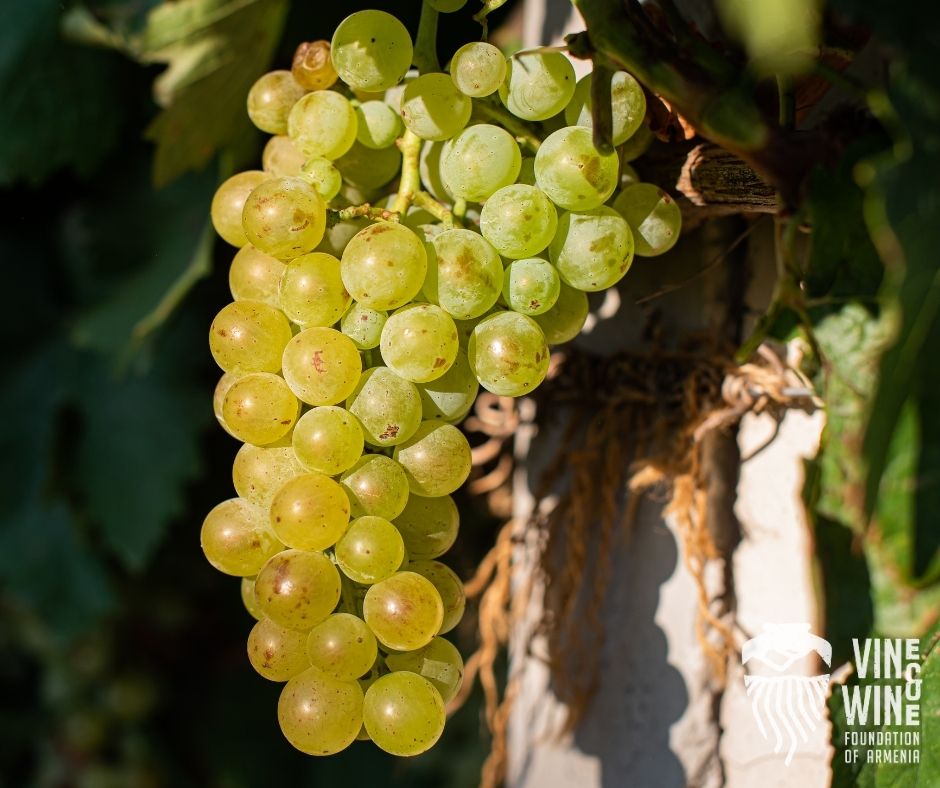Mskhali
Ampelographic characteristics:
 Sugar content: 19.2-23.0 %
Sugar content: 19.2-23.0 %
 Vines are tall. Leaves are medium-sized, rounded, green, thick and matte. Autumn color of leaves are yellow. Bunches are medium to large (can be up to 25-27 cm long), cylindrical. Berries are medium or large, round. The skin is firm and transparent. Pulp is juicy, fleshy, with pleasant flavor.
Vines are tall. Leaves are medium-sized, rounded, green, thick and matte. Autumn color of leaves are yellow. Bunches are medium to large (can be up to 25-27 cm long), cylindrical. Berries are medium or large, round. The skin is firm and transparent. Pulp is juicy, fleshy, with pleasant flavor.

Synonyms:
Dolband, Spitak Khahgohg, Miskhali
Resistance to diseases:
 Medium resistance to diseases and pests, not resistant to frost.
Medium resistance to diseases and pests, not resistant to frost.
Vegetative features:
 Late ripening grape variety. The variety reaches its technical ripeness in case if the sum of active temperatures is 3400 - 3800 °С in 165-170 days. Shoot maturation is good. Yield – 13-14 t/ha. In irrigated vineyards, growth is strong; yield is high and stable, however in different years there is a strong flower fall resulting in very loose clusters.
Late ripening grape variety. The variety reaches its technical ripeness in case if the sum of active temperatures is 3400 - 3800 °С in 165-170 days. Shoot maturation is good. Yield – 13-14 t/ha. In irrigated vineyards, growth is strong; yield is high and stable, however in different years there is a strong flower fall resulting in very loose clusters.
Climate conditions:
 The variety doesn’t demand particular soil structure or relief types. The yield is good in soil types that are full of clay and stones. The most optimal vine density while cultivated in Ararat valley is 2,7 * 2,0 м.
The variety doesn’t demand particular soil structure or relief types. The yield is good in soil types that are full of clay and stones. The most optimal vine density while cultivated in Ararat valley is 2,7 * 2,0 м.
 Wine characteristics:
Wine characteristics:
Mskhali is used in the production of high-quality table wines, fortified wines, and dessert
wines. It is optional for consuming freshly, as well as for winter storage and shipping.
Due to slow and relatively low sugar absorption and low acidity wines produced from
Mskhali are low-quality, with lack of freshness. The grape is the best demonstrated in fortifies
wine, particularly Armenian sherry production. The consumption of Mskhalin freshly as a table
grape is widely expended.
 Historic notes:
Historic notes:
Mskhali is a white indigenous Armenian table-technical grape variety, cultivated in
almost all winemaking regions of Armenia. It is considered one of the leading grape varieties in
Ararat, Artashat, Kotayk, and Armavir regions. Mskhali belongs to the eco-geographical group
of eastern cultivars. During the investigations of this variety, many different clones were found:
they are in the process of active studies now.

